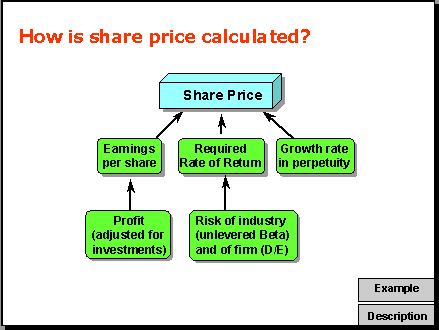
The evaluation of a share is an extension of the evaluation of a project or strategy - after all, the return from a firm is the return from all of its projects and strategies. So using the concept of NPV we can value a share.
Theoretically, this is the present value of all dividends that will be received from the share over its life. This time is considered to be infinity in the above example but can easily be adjusted for a finite length of time. The discount rate is the market capitalization rate, r (i.e. the return that the market wants on a similar security) less the expected growth rate of the dividend stream, g.
The issue is how to approximate Dividends. In MikesBikes-Advanced we assume all Earnings are returned as Dividends. While not entirely accurate, this makes the previous computation easier and relative share prices will stay the same. We adjust earnings by adding back some expenditures that will have a payback in the longer term. We are also assuming that future earnings are reflected in a weighted average of the past earnings. Again this is not particularly realistic, but does give a consistent way of estimating future earnings that is representative of how some shareholders tend to view their investments.
We also adjust risk to reflect the risk inherent in the industry and the risk of the firm as represented by the Debt/Equity ratio.